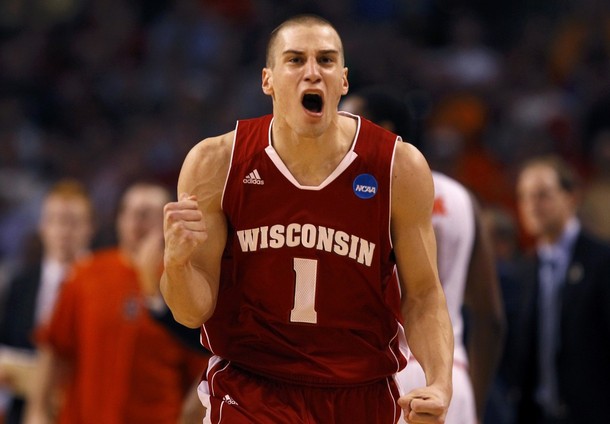Wisconsin’s Key To Success in the B1G Tournament: Defending the Three-Point Shot
Posted by Deepak Jayanti on March 17th, 2013Deepak is a writer for the Big Ten microsite of RTC. Follow him on Twitter for more about B1G hoops at @dee_b1g.
The three-point shot can hurt a team in more than one ways. When your guards are hitting the shot comfortably, it could serve as a foundation for extended runs and lets your home crowd raise their decibel level in the arena. Even if one of the sharpshooters hits two in a row within three possessions, the rest of the four guys on the floor inherently notice a boost in their confidence and the overall energy level goes up. On the flip side, if your “gunners” are struggling to hit their shots, every possession becomes very stressful and the rest of the players could stray away from the offensive game plan because they are frustrated. The Badgers have almost perfected this art of frustrating the opposing offenses by taking their perimeter game away. After two straight wins against top-15 teams – Indiana and Michigan – the Big Ten nation shouldn’t be surprised to see them in the final game at the United Center, but some may still be confused with their performance against the top teams. It is a simple formula: take away the perimeter game and force the opposition to be patient on offense and beat you using offensive sets that they may not be comfortable with and also avoid any extended runs of eight or ten points.
The Wolverines and the Hoosiers shot a combined 8-of-30 (27% 3FG) from beyond the arc against the Badgers over the weekend in Chicago. Indiana’s sharpshooter Jordan Hulls was 1-7 from beyond the arc because he was hounded by the Badgers’ Ben Brust repeatedly and the Wolverines’ gunner Nik Stauskas was 0-4 from deep. Brust was not even mentioned as a candidate for the defensive player of the year when the Big Ten announced their official awards because is fundamentally sound on defense but never makes the highlight reel by stealing the ball away or force turnovers when defending on a one-on-one basis. Nonetheless, he will simply get a hand in your face while you shoot a three, almost every time. The Wolverines ranked first in the conference by allowing their opponents to shoot just 28.1% from beyond the arc and they were first on defense in terms of effective FG% at 42.2%. Teams such as the Hoosiers and the Wolverines rely on their offense to stay motivated to play at a high level during the game and when they are not having their way on the offensive end, they’ll struggle on the defensive end as well. That’s why the Badgers were able to put up 68 points during both of the games over the weekend and dominated especially in the second half because the opposition was clearly letting their frustrations from the offensive end of the floor to dictate their defensive intensity.
Regardless of what happens in the Big Ten tournament final, the Badgers have shown enough this season to prove that they are a contender for a Sweet 16 appearance in the NCAA tournament. Could they get past the second weekend? Absolutely because as long as they continue to put up 65 points because they will force even the best of the teams such as Kansas, Louisville or Duke to work relentlessly for every point. In other words, because of their defense, the Badgers will always hang around a game and won’t get blown out because they will not let the opposing guards score in bunches by taking away the shot from the perimeter. Seems simple enough, but Bo Ryan’s team has perfected that plan this season.










































